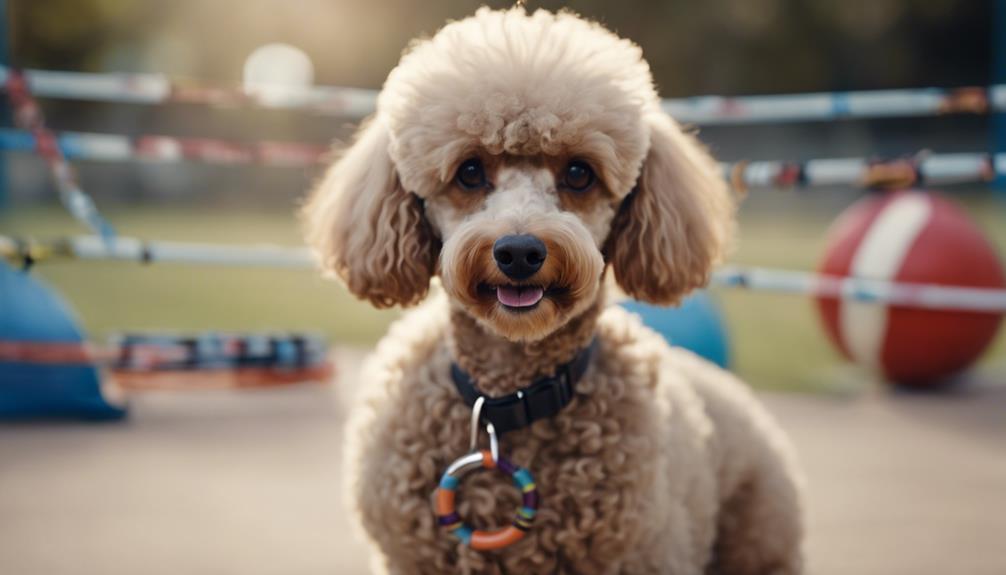Have you heard that 83% of poodle owners who incorporate clicker training notice a significant improvement in their dog's responsiveness? Imagine the possibilities when you tap into this effective training method. By mastering the art of timing and reinforcement, you can unlock your poodle's potential for learning and cooperation in ways you never thought possible.
Key Takeaways
- Clicker training enhances communication and bonding with your Poodle.
- Consistent positive reinforcement builds trust and strengthens the training routine.
- Use high-value rewards and clear signals for effective behavior shaping.
- Tailor training sessions to your Poodle's needs for efficient learning and a strong bond.
Clicker Training Basics for Poodles

To effectively begin clicker training with your Poodle, it is essential to understand the foundational principles that underpin this positive reinforcement technique. Poodles, known for their intelligence and responsiveness, are particularly well-suited for clicker training. By utilizing a clicker, a small device that makes a distinct sound, you can shape your Poodle's behaviors effectively. Positive reinforcement is key in this training method, as Poodles thrive on encouragement and rewards for good behavior. Consistency is paramount when using the clicker to communicate with your Poodle. By clicking at the precise moment your Poodle exhibits the desired behavior, you are effectively communicating what you expect. This clear communication aids in behavior shaping and helps your Poodle understand what is being reinforced. Through consistent clicker training sessions, you not only train your Poodle but also strengthen the bond between you and your furry companion.
Understanding Operant Conditioning for Poodles

Understanding operant conditioning for your poodle is crucial in shaping their behaviors effectively. By utilizing positive reinforcement techniques, you can strengthen desired behaviors and create a harmonious training environment. Consistency and clear communication play a vital role in successfully implementing operant conditioning methods with your furry companion.
Poodle Behavior Shaping
By shaping behaviors through positive reinforcement, Poodle owners can effectively utilize operant conditioning techniques to train their furry companions. Behavior shaping in Poodles involves breaking down complex actions into smaller achievable steps, which are then reinforced using positive feedback, like a clicker. This method helps Poodles understand what is expected of them and encourages them to exhibit the desired behaviors. Consistent use of the clicker to mark these small achievements creates a clear communication channel between you and your Poodle, fostering a strong bond and enhancing the training experience. Below is a table illustrating how behavior shaping works in Poodles:
| Step 1: | Step 2: | Step 3: | Step 4: | Step 5: |
|---|---|---|---|---|
| Capture Poodle's attention | Reward for acknowledging command | Shape behavior gradually | Click and treat for correct actions | Refine behavior through repetition |
Positive Reinforcement Techniques
Using positive reinforcement techniques is key to effectively training your Poodle through operant conditioning principles. Clicker training, a form of dog training that falls under operant conditioning, can help shape your Poodle's behavior effectively. By associating the click sound with a reward, like a treat, you can communicate to your Poodle when they exhibit the desired behavior. This immediate feedback helps your Poodle understand what they did right. Positive reinforcement techniques, such as clicker training, not only aid in teaching new behaviors but also in reinforcing existing ones. Consistency in rewarding good behavior with a click followed by a treat establishes a strong connection between the behavior and the reward, making the training process more efficient and enjoyable for both you and your Poodle.
Clicker Training Techniques for Poodles
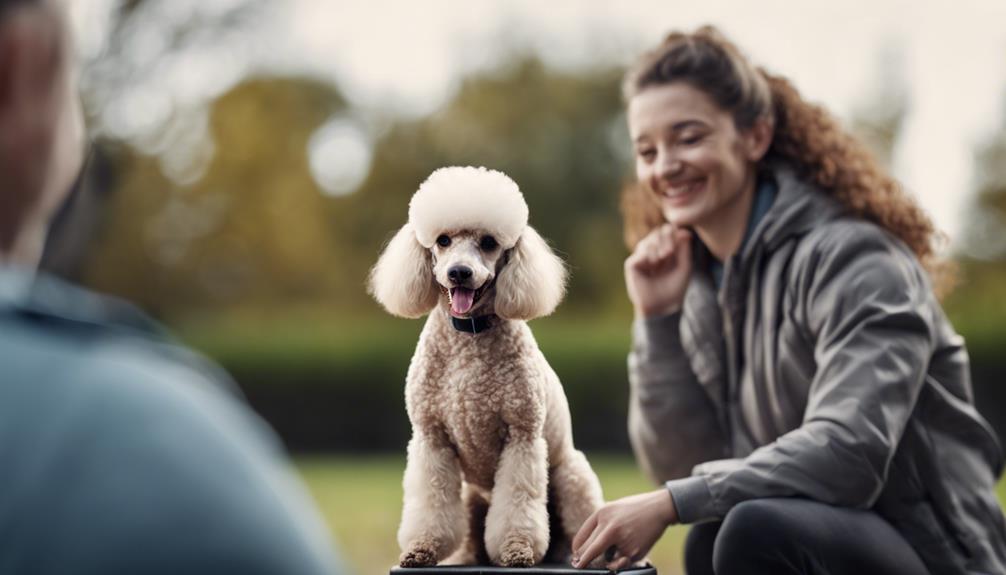
When training your Poodle with a clicker, remember that timing is crucial for effective communication. Consistency in your training sessions will help your Poodle understand what behaviors are being reinforced. By focusing on precise timing and consistent cues, you can build a strong communication foundation with your Poodle through clicker training.
Timing in Clicker Training
Timing plays a critical role in clicker training for Poodles, ensuring the precise marking of desired behaviors with the click. To effectively utilize timing, click immediately after your Poodle displays the desired behavior. This prompt association between behavior and reward helps your Poodle understand which actions are being reinforced. Consistent and precise timing of the clicker is key to your Poodle's quick and effective learning. By mastering the correct timing, you enhance communication with your Poodle, strengthening the training process. Remember, accurate timing is the foundation of successful clicker training, setting the stage for clear communication and positive reinforcement in your Poodle's learning journey.
Consistency With Poodles
Consistency is key when implementing clicker training techniques with Poodles, ensuring a structured approach that aligns with their need for predictability and routine. Poodles' intelligence and sensitivity require a positive and consistent training environment. Use high-value treats to reinforce good behavior effectively. Adjust the training pace to match their learning curve, keeping sessions engaging and successful. Incorporate fun activities to maintain their interest and motivation. Establish a regular schedule for training to create a sense of routine for your Poodle. By following these guidelines, you can make clicker training a rewarding experience for both you and your furry companion.
| Consistency With Poodles | |
|---|---|
| Use clicker training | Ensure a positive and consistent training approach. |
| High-value treats | Use treats that Poodles find rewarding to reinforce behaviors. |
| Adjust training pace | Match the learning curve of Poodles to keep training successful. |
| Regular schedule | Establish a routine to provide predictability for your Poodle. |
| Fun and engaging activities | Incorporate enjoyable tasks into training sessions to keep your Poodle motivated. |
Marker Words for Poodle Behavior
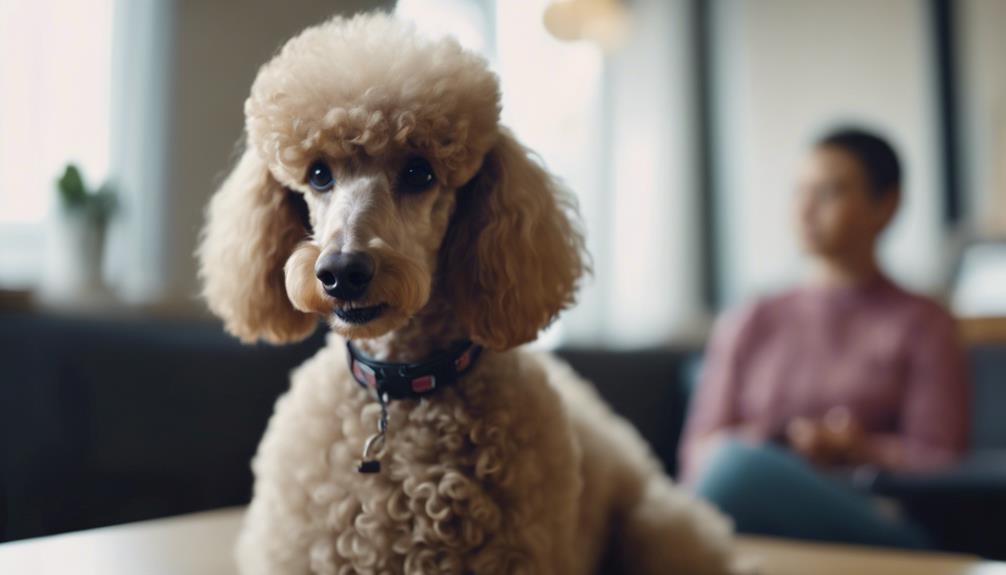
Incorporating marker words into your clicker training routine can significantly enhance your Poodle's learning experience and behavior comprehension. Verbal markers such as 'good' or 'yes' can effectively replace the clicker in clicker training sessions for Poodles. By consistently using marker words, you provide immediate feedback and reinforcement for your Poodle's desired behaviors during training sessions. These marker words help in maintaining clear communication with your Poodle, aiding in their understanding of what you expect from them.
When you integrate marker words into clicker training, you facilitate a smooth transition away from the clicker while still ensuring that your Poodle receives timely and positive feedback. Poodles are quick learners and can easily associate these marker words with positive outcomes, making the training process more effective. Through the use of marker words, you can create a structured and rewarding training environment that fosters a deeper bond and understanding between you and your Poodle.
Reward Systems for Poodle Training
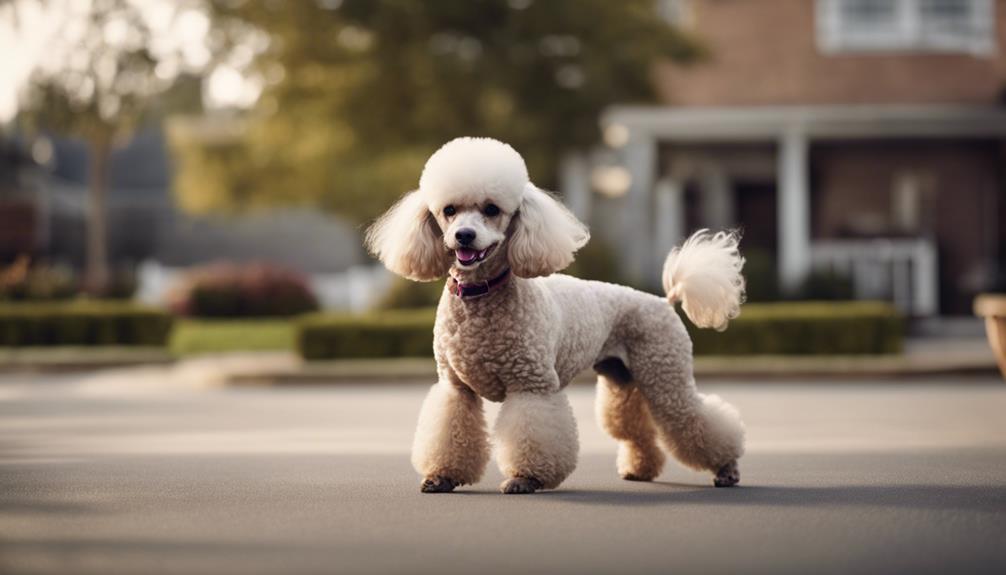
Enhancing your Poodle's training experience involves implementing effective reward systems that cater to their motivation and learning preferences. When training your Poodle using reward-based methods, consider the following:
- Choose High-Value Treats: Poodles respond well to treats like small pieces of chicken or cheese, which can serve as strong motivators during training sessions.
- Incorporate Praise and Encouragement: Alongside treats, use praise and verbal encouragement to reinforce positive behaviors and strengthen the reward system.
- Be Consistent: Consistency in rewarding desired behaviors helps Poodles understand expectations and reinforces good actions effectively.
- Keep it Varied: Vary the types of rewards given to your Poodle. Incorporating playtime or interactive toys can help keep your Poodle engaged and motivated throughout training sessions.
Teaching Basic Commands to Poodles
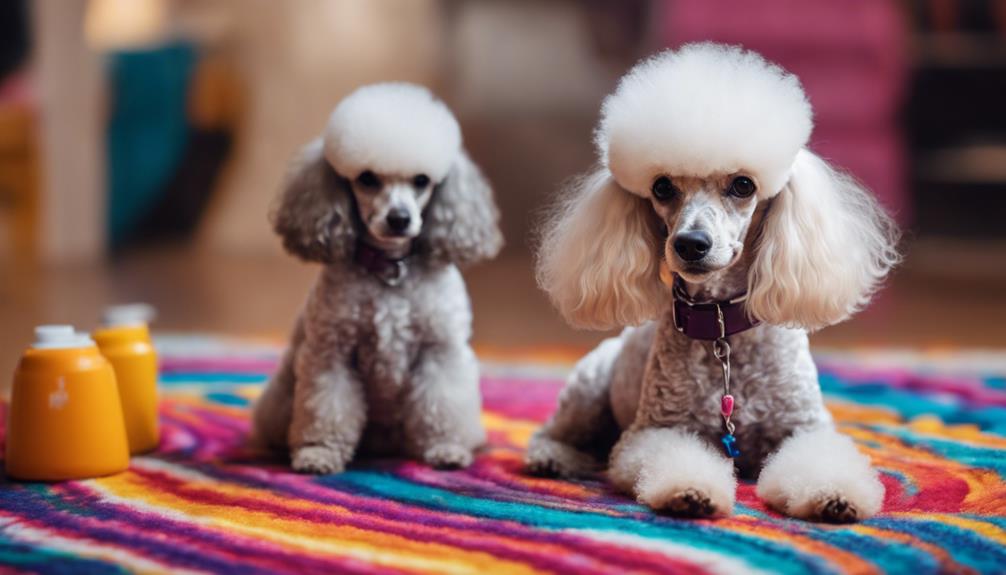
When teaching basic commands to your Poodle, focus on establishing a strong foundation with essential commands like sit, stay, come, and down. Employ positive reinforcement techniques such as clicker training to effectively communicate and reward your Poodle's correct responses. Consistency in timing and rewards is vital for clear communication and successful command execution.
Command Foundation Essentials
Establishing a strong foundation for your Poodle's training begins with teaching them basic commands like sit, stay, come, and down. Here are essential aspects to consider:
- Consistency: Regular practice of basic commands is vital for your Poodle's learning.
- Positive Reinforcement: Rewarding good behavior with treats or praise reinforces obedience.
- Clear Communication: Use concise cues to help your Poodle understand what you expect.
- Building Blocks: Mastering basic commands forms the basis for advanced training and desired behaviors.
Positive Reinforcement Techniques
To effectively teach basic commands to your Poodle using positive reinforcement techniques, start by incorporating clicker training as a rewarding method. Use high-value treats to reinforce correct responses immediately after clicking for commands like sit, stay, come, and down. Consistency is key; ensure you click and reward each time your Poodle follows a command correctly. Begin with simple commands and gradually increase difficulty to challenge your Poodle's learning. Remember, patience and persistence are essential when integrating clicker training. By practicing these techniques consistently, you can effectively teach your Poodle basic commands while strengthening your bond through positive reinforcement.
Integrating Hand Signals for Poodles

Incorporate hand signals into your poodle's training routine to enhance communication and reinforce desired behaviors effectively. Poodles, known for their responsiveness to visual cues, greatly benefit from incorporating hand signals alongside verbal commands during training sessions. Here are some key points to consider when integrating hand signals for your poodle:
- Visual Cues: Poodles respond well to visual cues, making hand signals a valuable addition to their training routine.
- Enhanced Communication: Hand signals help poodles understand commands in noisy or crowded environments where verbal cues may be less effective.
- Reinforcement of Behaviors: Consistent use of hand signals alongside verbal commands can enhance communication and reinforce desired behaviors effectively.
- Improved Focus and Obedience: Training poodles with hand signals can improve their focus, responsiveness, and overall obedience during training sessions.
Consistency in Poodle Clicker Training
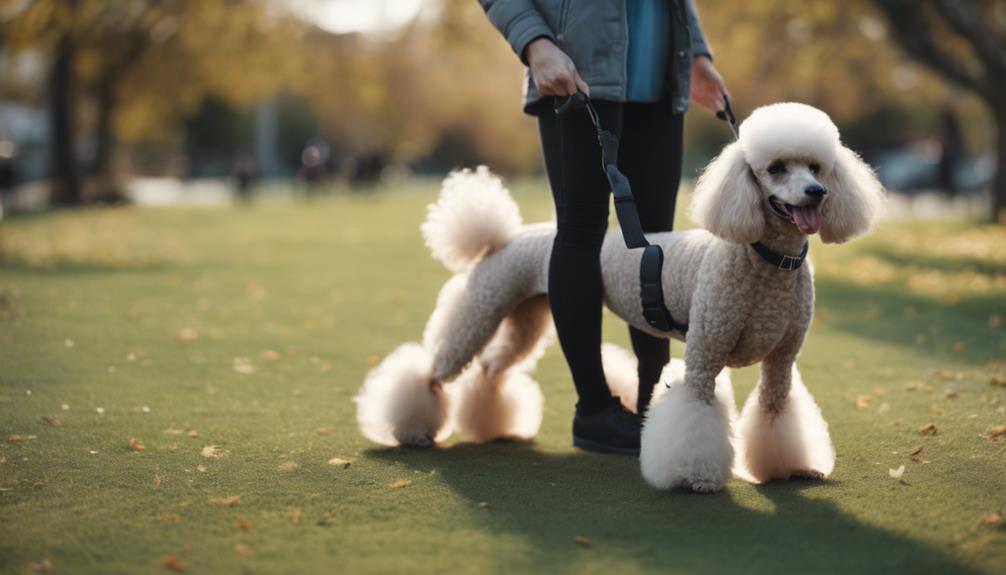
Maintaining consistency in clicker training for your Poodle is key to their success. By ensuring timely clicks and offering rewards promptly, you help reinforce positive behaviors effectively. Remember, consistent clicker training fosters a strong bond between you and your Poodle, making the learning process enjoyable and rewarding for both of you.
Timing in Clicker Training
Consistent timing in clicker training is essential for effectively communicating with your poodle and reinforcing desired behaviors. When training your poodle using the clicker, precise timing plays a crucial role in helping them understand which behaviors lead to rewards. Here are some key points to consider:
- Clear Communication: Timing the click accurately helps your poodle associate the behavior with the reward.
- Effective Reinforcement: Poodles respond well to precise timing, making it easier to reinforce the desired behaviors.
- Quick Learning: Consistent timing in training sessions helps poodles learn quickly and retain the learned behaviors.
- Enhanced Understanding: Precision in timing the clicker enhances your poodle's understanding of the rewarded behavior, facilitating a smoother training process.
Rewards for Poodles
To ensure effective communication and reinforcement in clicker training for your poodle, it is crucial to select rewards that resonate with their preferences and maintain consistency in their delivery. Poodles respond well to high-value treats such as small pieces of chicken or cheese during clicker training sessions. Consistent reward delivery helps Poodles understand the connection between the click sound and positive outcomes. Mixing up the rewards with variety keeps Poodles engaged and motivated in their training sessions. By tailoring rewards to your Poodle's likes, you ensure they stay motivated and eager to participate in clicker training. Remember, using a combination of rewards that your Poodle loves will enhance their motivation and make the training experience enjoyable for both of you.
Positive Reinforcement Methods for Poodles
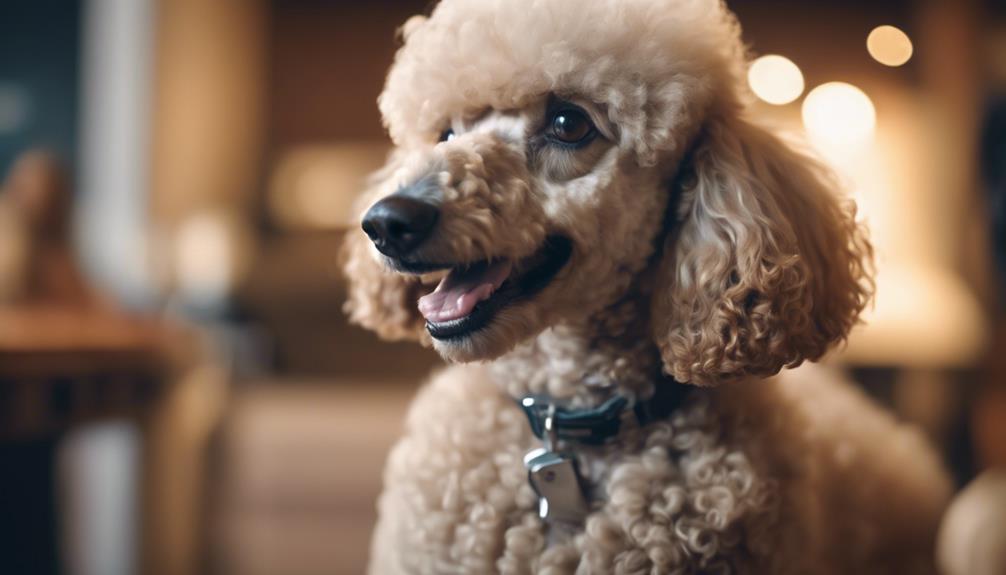
Using high-value treats as rewards can effectively reinforce desired behaviors in Poodles during clicker training. Here are some positive reinforcement methods to help you enhance your Poodle's training experience:
- Consistent Rewarding: Ensure you reward your Poodle promptly after the desired behavior is exhibited to establish a clear connection between the action and the treat.
- Variety in Treats: Rotate high-value treats to keep your Poodle engaged and motivated during training sessions, preventing treat habituation.
- Short, Frequent Sessions: Keep training sessions short and frequent to maintain your Poodle's focus and prevent boredom, making learning more effective.
- Praise and Affection: Alongside treats, use verbal praise and physical affection to reinforce good behaviors, strengthening the bond between you and your Poodle.
Advancing Training With Poodles
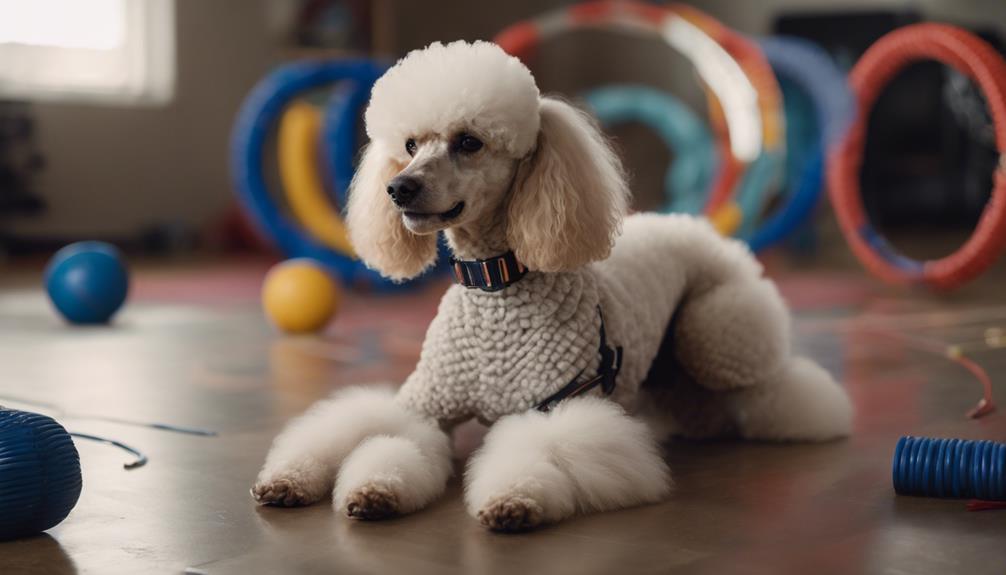
As you progress in training your Poodle, consider exploring advanced techniques that capitalize on their intelligence and responsiveness to clicker training. Poodles are highly intelligent and excel in advanced clicker training, where you can teach them complex tricks, agility skills, and obedience commands with precision. These advanced sessions provide the mental stimulation that Poodles crave, offering a fun and engaging way to challenge their intellect while enhancing their focus and problem-solving abilities.
To advance your Poodle's training effectively, focus on building upon their foundational skills. Gradually increase the difficulty of tasks to keep them engaged and motivated. Consistency is key in advanced clicker training; maintaining a regular routine will yield optimal results in your Poodle's performance. By incorporating advanced clicker training in your Poodle's routine, you can deepen your bond with them while honing their skills to an impressive level.
Troubleshooting Poodle Training Challenges
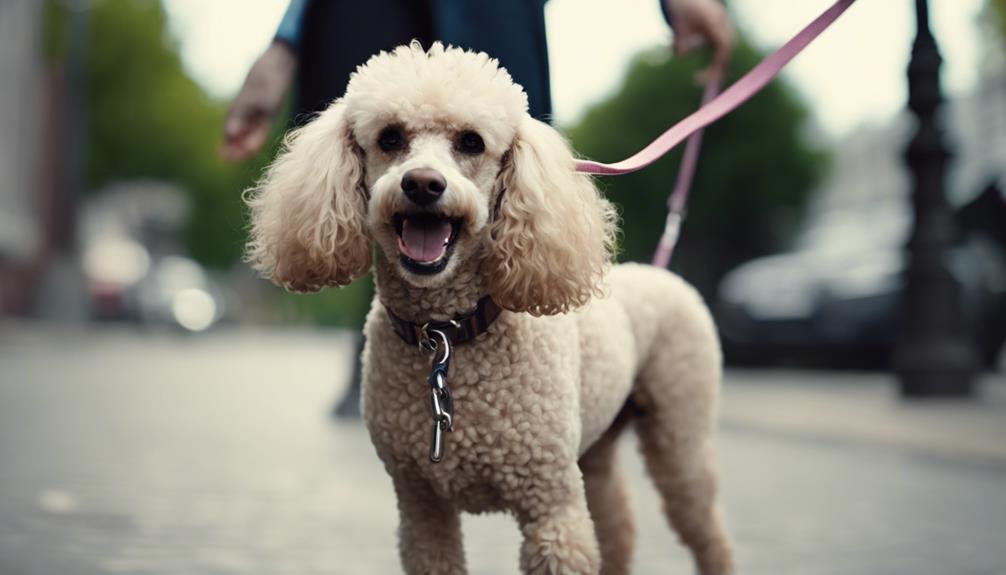
If your Poodle is facing training challenges, understanding their individual temperament and adjusting your approach accordingly can lead to more successful outcomes. Here are some tailored techniques to help you troubleshoot common Poodle training issues:
- Consistent Positive Reinforcement: Utilize clicker training and positive reinforcement to motivate your Poodle and reinforce good behavior effectively.
- Managing Distractions: Address distractions in your training environment to help your Poodle focus better and improve responsiveness during sessions.
- Short Training Sessions: Implement short, frequent training sessions to prevent boredom, maintain engagement, and optimize learning for your Poodle.
- Seek Professional Guidance: Consider seeking professional guidance or attending obedience classes to gain specialized solutions and insights for overcoming specific Poodle training challenges.
Creating a Poodle Training Routine
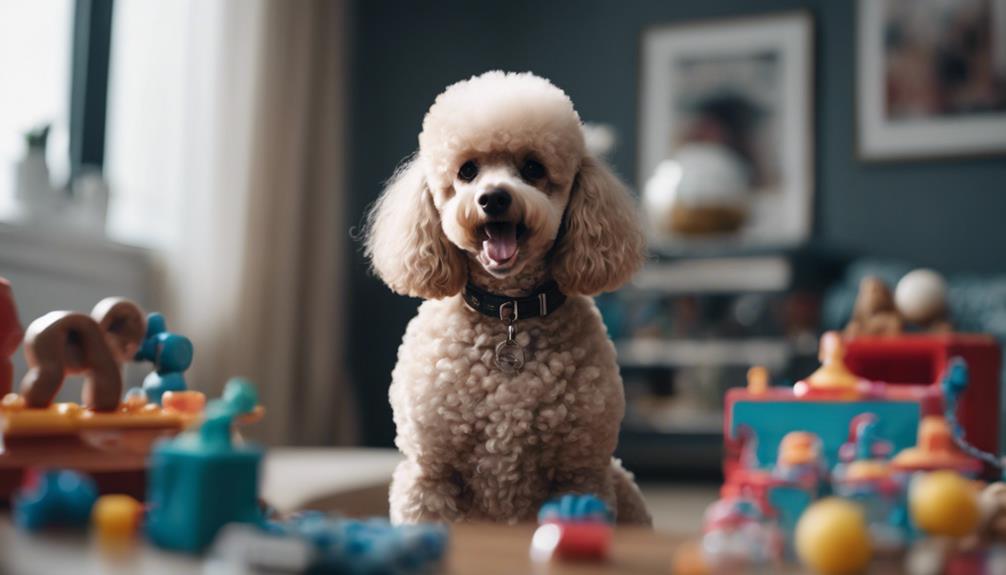
To establish a successful training routine for your Poodle, consistency and variety in daily sessions play a crucial role in fostering engagement and progress. Incorporate clicker training into your routine to reinforce positive behaviors effectively. Schedule multiple short training sessions throughout the day to keep your Poodle engaged and attentive. Introduce a variety of commands and behaviors to challenge your Poodle's mental agility and prevent boredom. It's essential to create a distraction-free environment during training to optimize learning and retention. Monitor your Poodle's progress closely to track improvements and areas needing more focus. Be prepared to adjust the training routine as needed to address any challenges or setbacks promptly. By maintaining consistency, incorporating variety, and adapting to your Poodle's needs, you can create a training routine that strengthens your bond and enhances your Poodle's skills.
Building Trust and Bonding With Poodles

Building trust and bonding with your Poodle can be effectively achieved through consistent clicker training sessions that foster clear communication and positive reinforcement. Poodles, known for their intelligence, respond well to this training method, allowing for a deeper connection between you and your furry companion.
Here are four essential ways clicker training can help build trust and enhance bonding with your Poodle:
- Clear Communication: Clicker training provides a precise way to communicate with your Poodle, helping them understand desired behaviors effectively.
- Positive Reinforcement: By rewarding good behavior with treats or praise, you create a positive association for your Poodle, strengthening trust and bonding.
- Enhanced Confidence: Through clicker training, poodles gain confidence in their abilities, leading to a more secure and trusting relationship with their owners.
- Reduced Anxiety: Consistent clicker training sessions offer a sense of predictability and structure, reducing anxiety in poodles and fostering a stronger bond based on trust and mutual understanding.
Enhancing Communication With Poodles

Enhancing communication with your Poodle through clicker training can significantly strengthen your bond and deepen your understanding of each other's needs and cues. Clicker training allows for precise marking of behaviors, enabling your Poodle to grasp desired actions more quickly and leading to improved training outcomes. The consistent sound of the clicker serves as a clear signal of positive reinforcement, helping your Poodle associate specific behaviors with rewards and facilitating effective communication during training sessions.
Frequently Asked Questions
How Do I Introduce My Dog to Clicker Training?
To introduce your dog to clicker training, start by associating the clicker sound with treats for positive reinforcement. Be consistent with the clicker to mark desired behaviors and time the click right for effective communication. Stay patient and maintain training consistency for success.
Why Not to Use Clicker for Dog Training?
Sometimes, traditional methods may be more suitable for certain dogs with different learning styles. Lack of consistency, special needs dogs, timing issues, distraction challenges, and personal preferences can all be reasons why not to use a clicker for dog training.
Is It Better to Train Dogs With a Clicker or Yes?
When training dogs, using a clicker offers precise feedback and enhances positive reinforcement. It ensures consistency, improves timing, and strengthens the association between behavior and reward. Compared to verbal cues like 'yes,' clickers provide clearer communication and better results.
Can You Use a Dog Clicker for Bad Behavior?
Yes, you can use a dog clicker to address bad behavior, but it's crucial to focus on positive reinforcement and behavioral modification. Consistency is key in redirecting focus and training alternatives. Patience and using the clicker as a communication tool are essential.
Conclusion
In conclusion, integrating clicker training into your poodle's routine can lead to effective communication, improved performance, and a stronger bond between you and your furry companion. Did you know that studies have shown that clicker-trained dogs learn new behaviors faster and retain them longer than those trained with traditional methods? By incorporating clicker training techniques into your poodle's training routine, you can help them reach their full potential and enhance your relationship with them.
